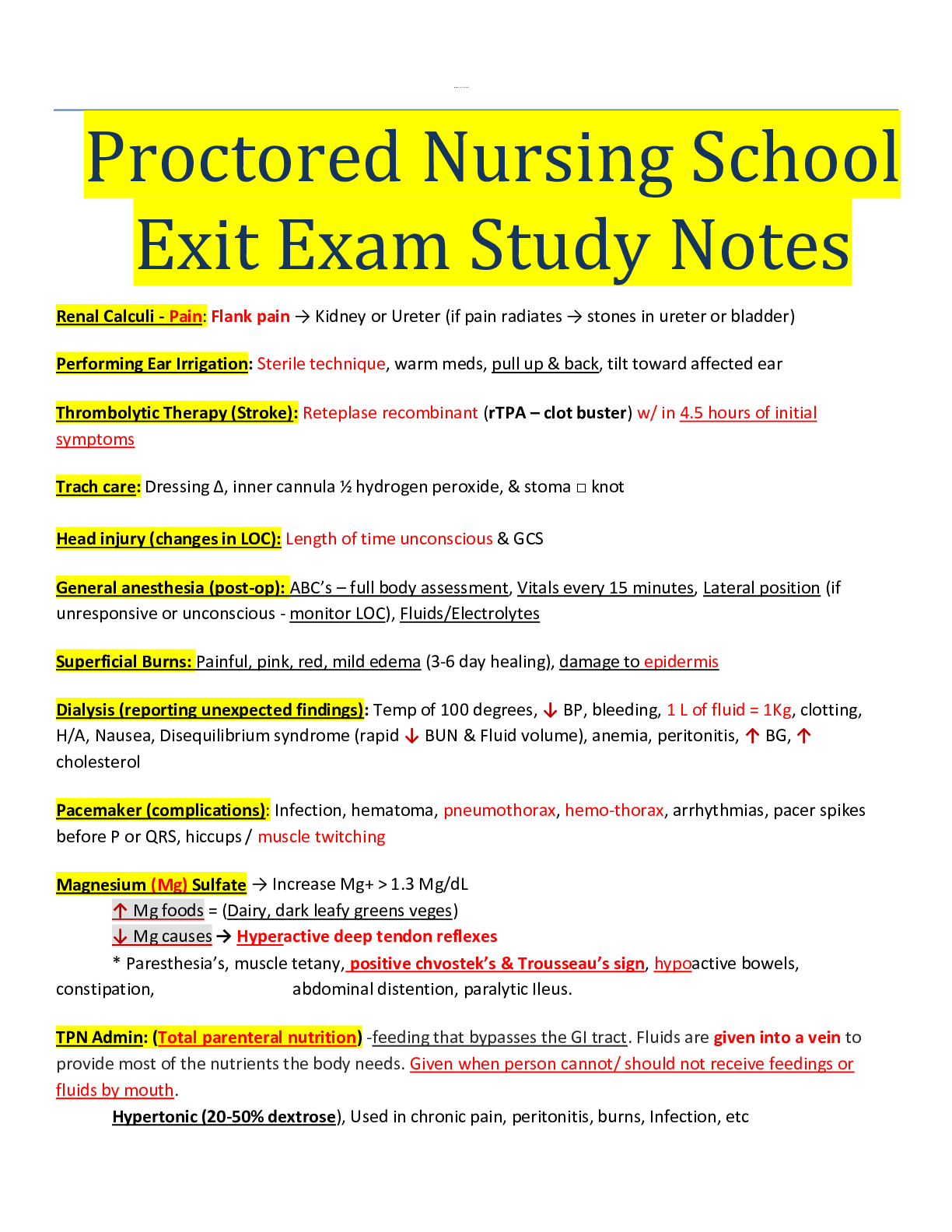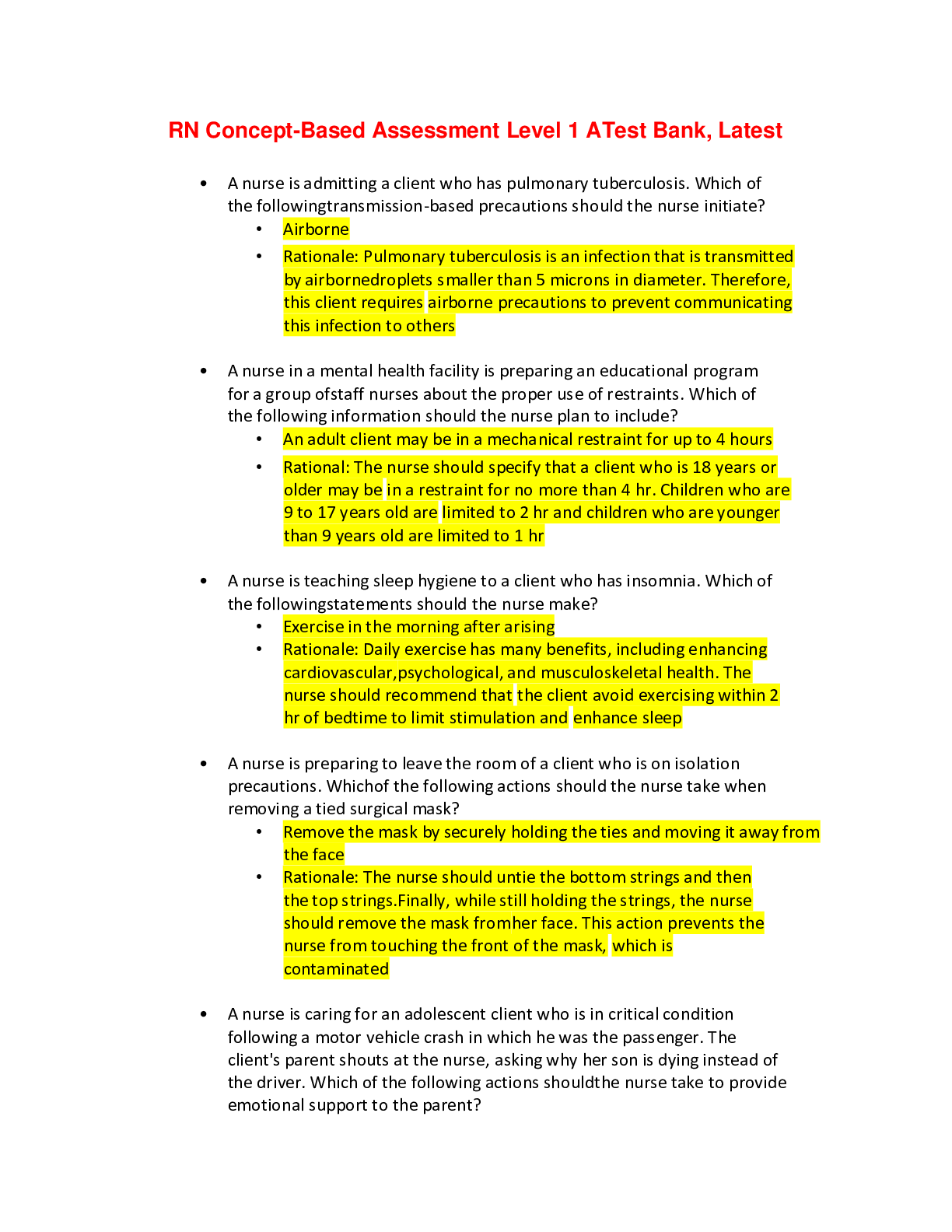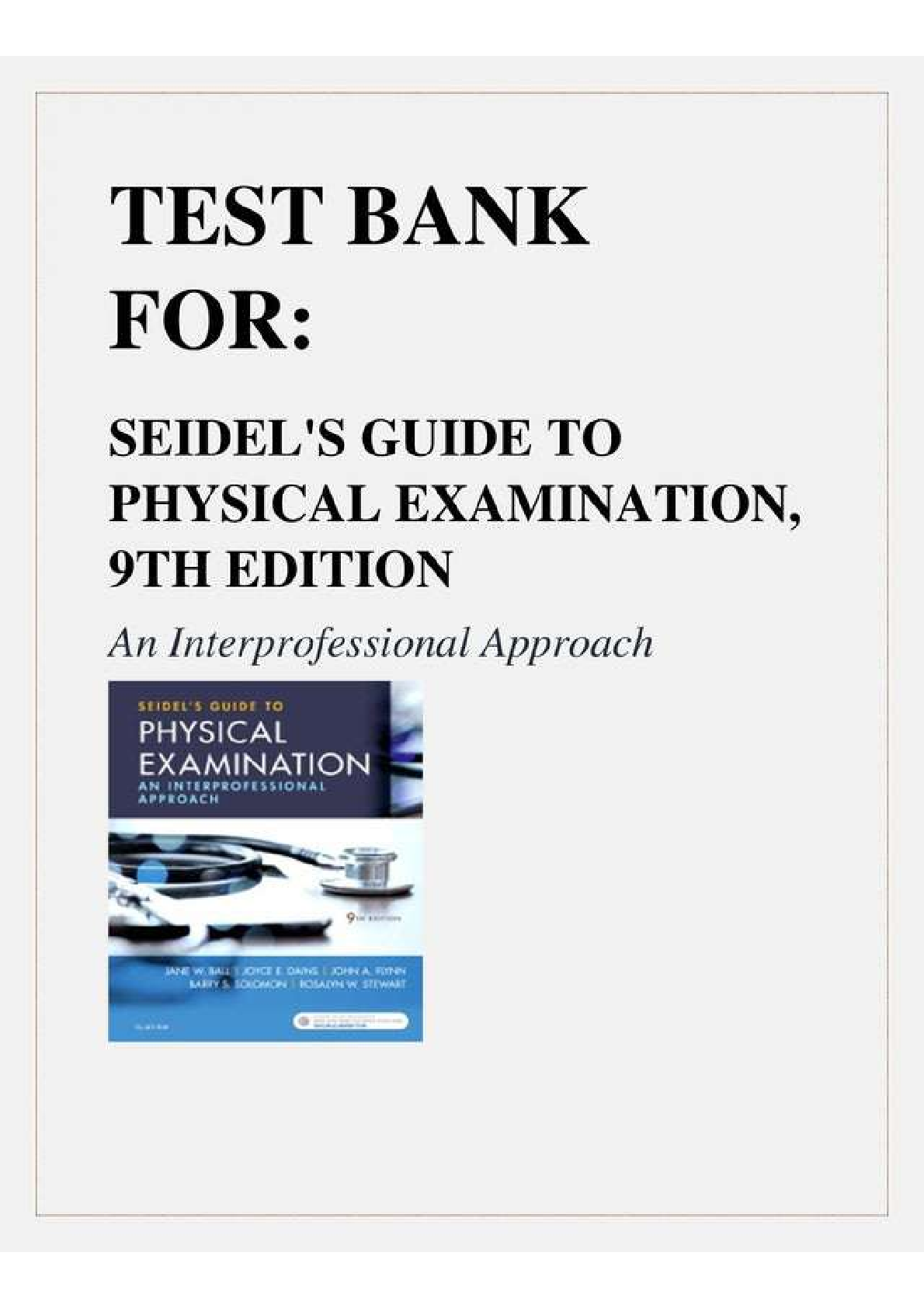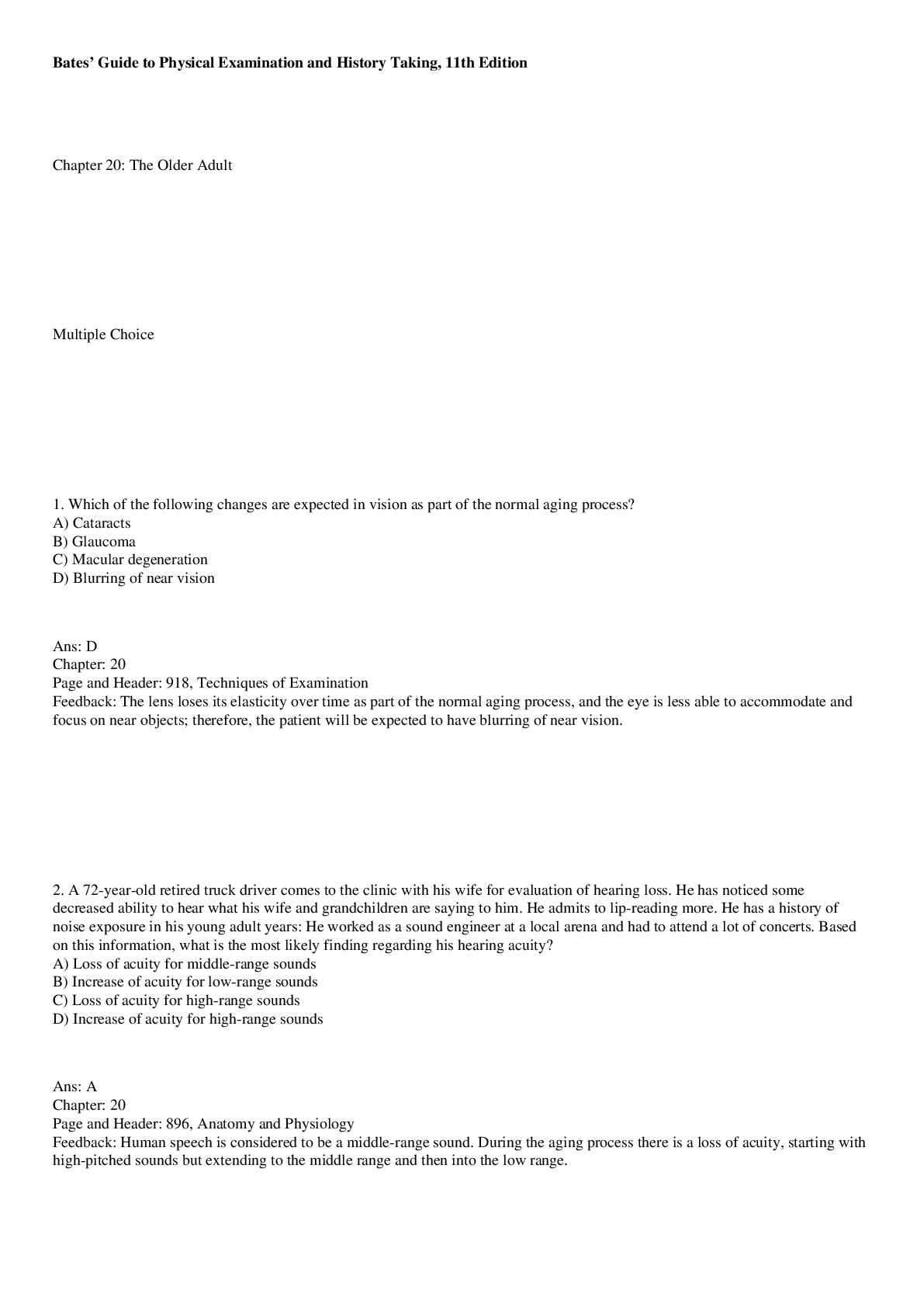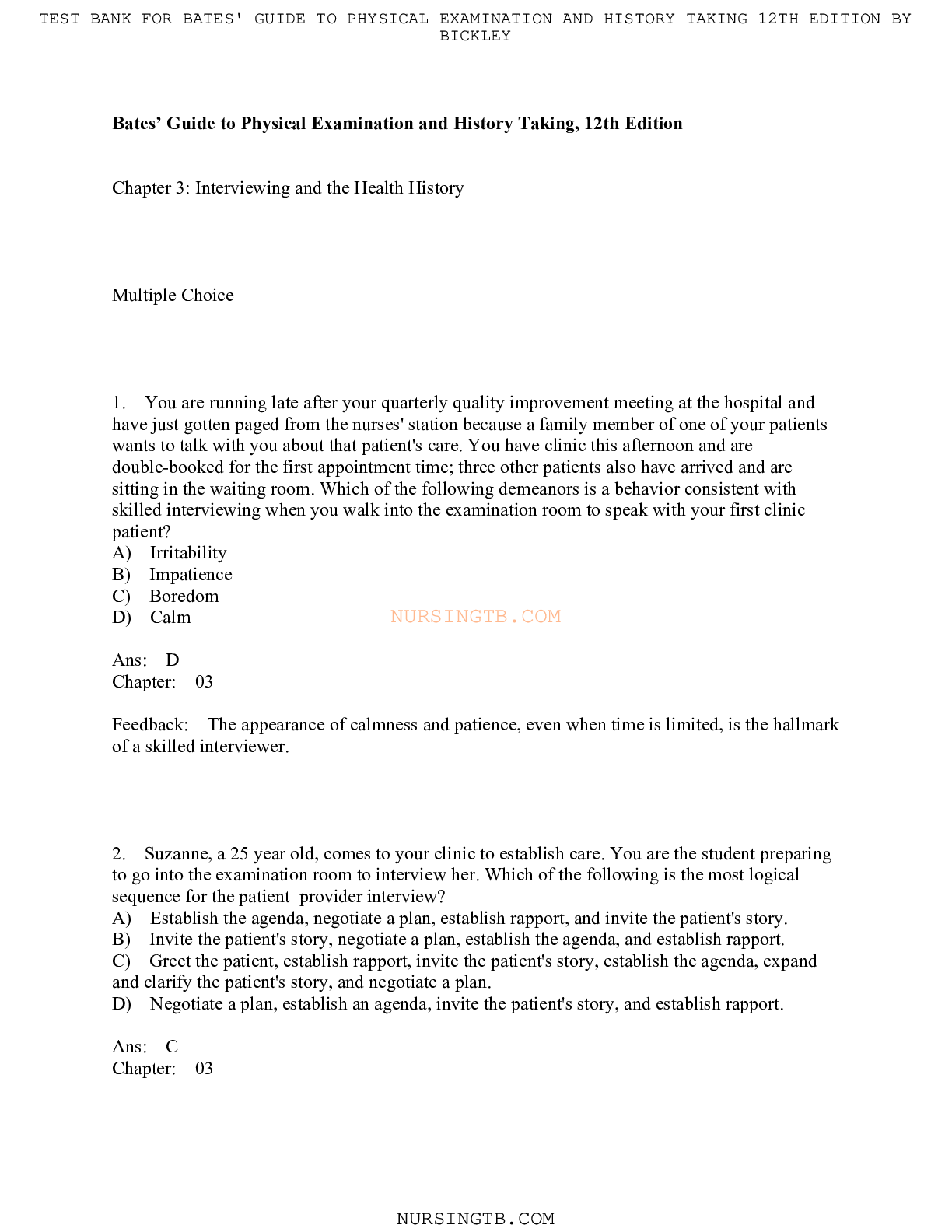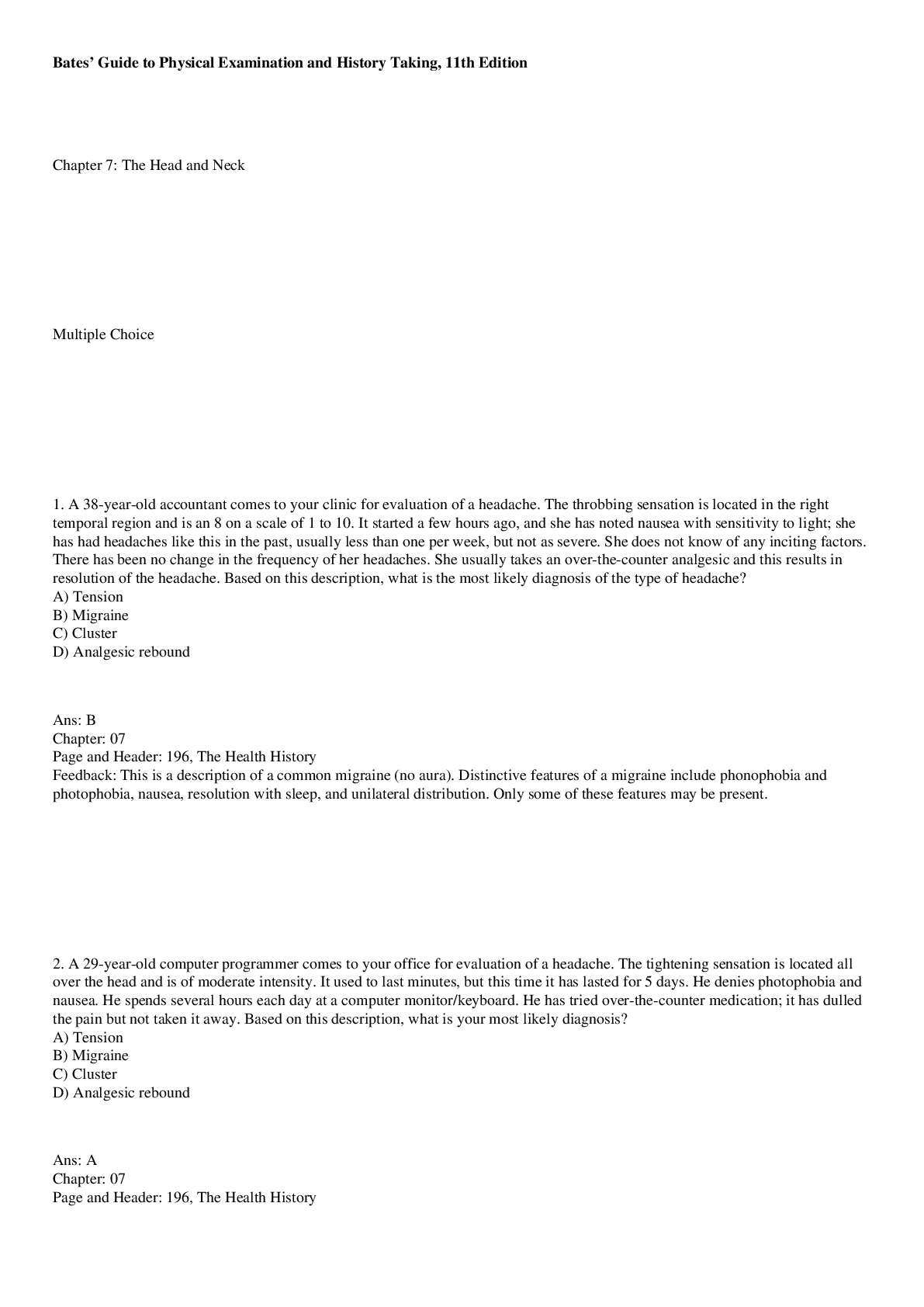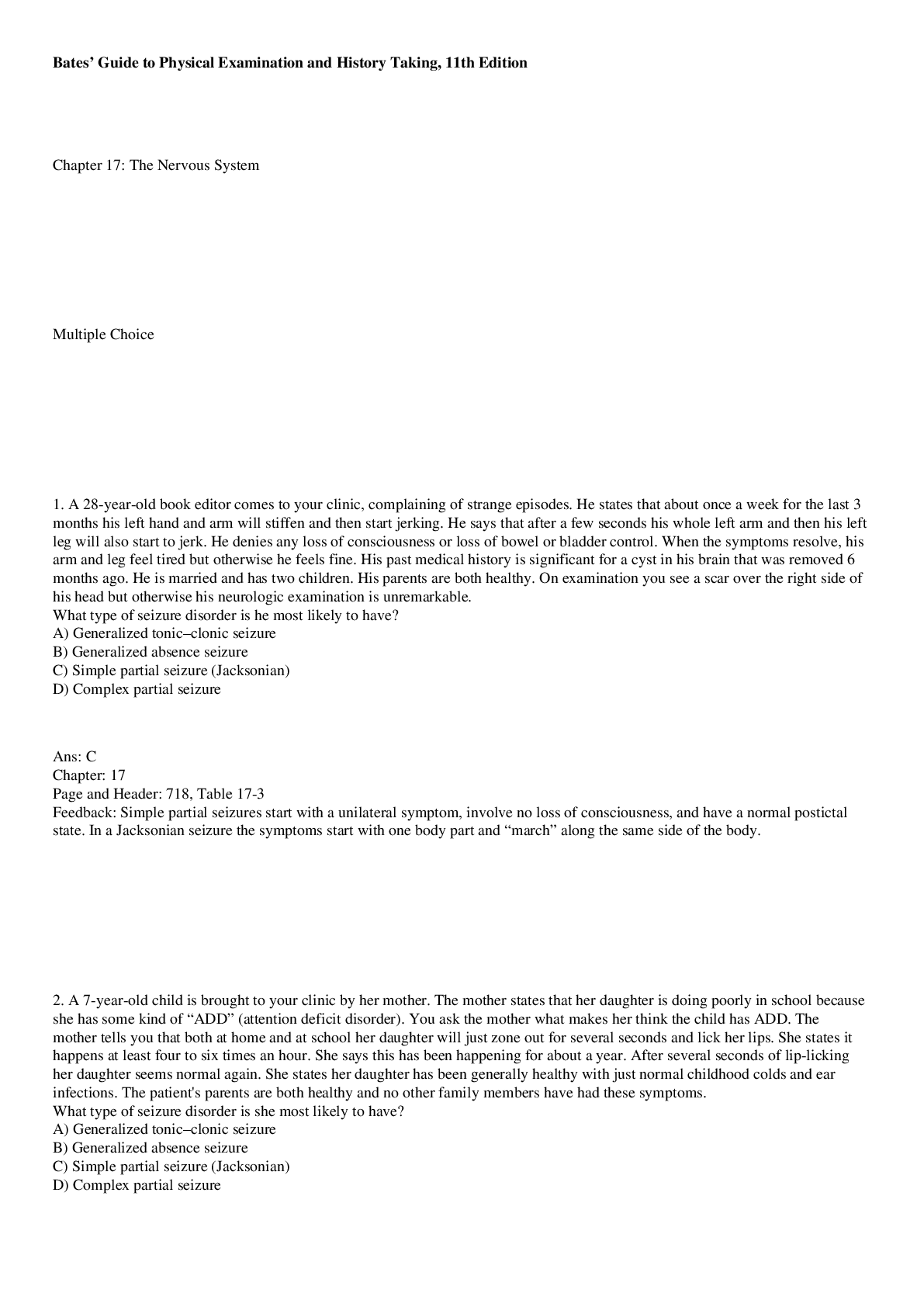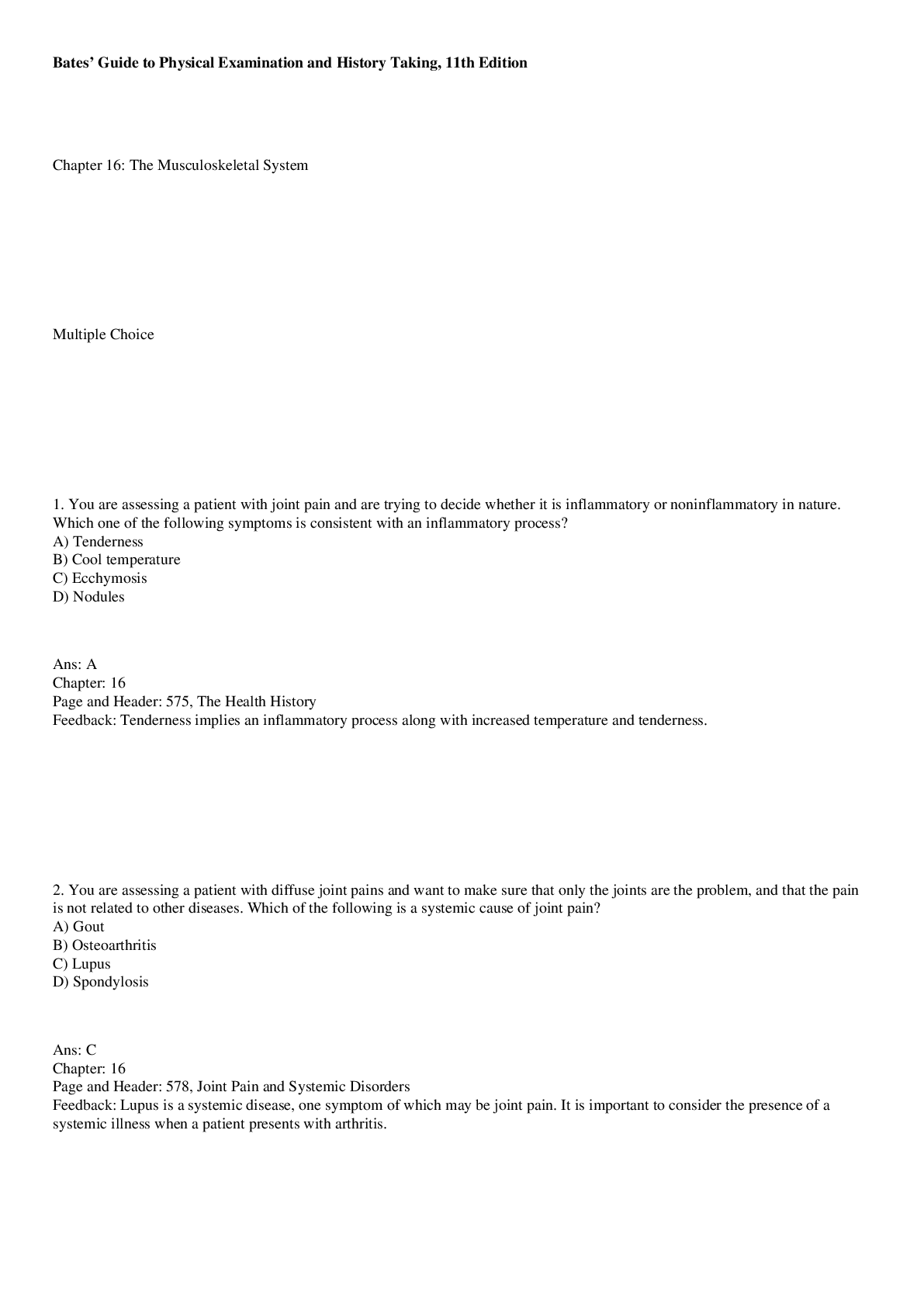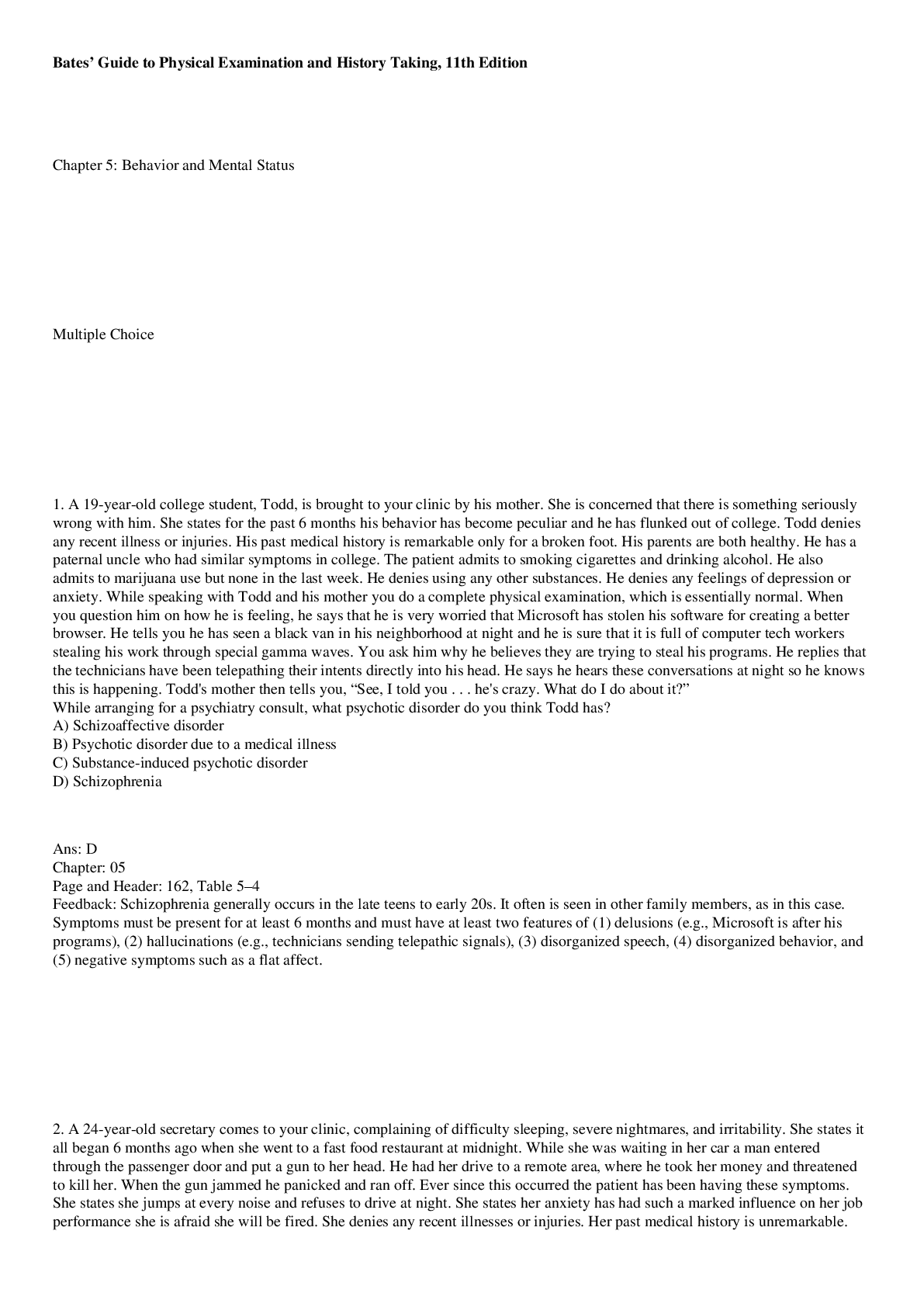*NURSING > TEST BANK > Chapter 02: Cultural Competency/Ball: Seidel’s Guide to Physical Examination, 9th Edition/ comolet (All)
Chapter 02: Cultural Competency/Ball: Seidel’s Guide to Physical Examination, 9th Edition/ comolete solution
Document Content and Description Below
Chapter 02: Cultural Competency Ball: Seidel’s Guide to Physical Examination, 9th Edition MULTIPLE CHOICE 1. Which statement is true regarding the relationship of physical characteristics ... and culture? 2. An image of any group that rNejecRts itIs poGtenBtia.l Cfor Moriginality or individuality is known as a(n): 3. Mr. L presents to the clinic with severe groin pain and a history of kidney stones. Mr. L’s son tells you that for religious reasons, his father wishes to keep any stone that is passed into the urine filter that he has been using. What is your most appropriate response? 4. The motivation of the healthcare professional to “want to” engage in the process of becoming culturally competent, not “have to,” is called: 5. Mr. Marks is a 66-year-old patient who presents for a physical examination to the clinic. Which question has the most potential for exploring a patient’s cultural beliefs related to a health problem? 6. The definition of ill or sick is based on a: 7. A 22-year-old female nurse is interviewing an 86-year-old male patient. The patient avoids eye contact and answers questions only by saying, “Yeah,” “No,” or “I guess so.” Which of the following is appropriate for the interviewer to say or ask? 8. As you explain your patient’s condition to her husband, you notice that he is leaning toward you and pointedly blinking his eyes. Knowing that he is from England, your most appropriate response to this behavior is to: 9. An aspect of traditional Western medicine that may be troublesome to many Hispanics, Native Americans, Asians, and Middle Eastern groups is Western medicine’s attempts to: a. restore balance in an individual’s life. ANS: B A more scientific approach to healthcare problem solving, in which a cause can be determined for every problem in a precise way, is a Western approach. Hispanics, Native Americans, Asians, and Arabs embrace a more holistic approach. Using a holistic approach, establishing harmony between a person and the entire cosmos, and restoring balance in an individual’s life would not be troublesome to many Hispanics, Native Americans, Asians, and Arabs. DIF: Cognitive Level: Understanding (Comprehension) OBJ: Nursing process—assessment MSC: Physiologic Integrity: Physiologic Adaptation 10. The attitudes of the healthcare professional: a. are largely irrelevant to the success of relationships with the patient. b. do not influence patient behavior. c. are difficult for the patient to sense. d. are culturally derived. ANS: D The attitudes of the healthcare provider are foundationally derived from his or her own culture; understanding this is relevant to the success of patient relationships. Attitudes of the healthcare professional are easily detected by others, and they influence patient behavior; they are not irrelevant to the success of relationships with the patient; they do influence patient behavior; and they are not difficult for the patient to sense. 11. 11. DIF: Cognitive Level: Understanding (Comprehension) OBJ: Nursing process—assessment MSC: Physiologic Integrity: Physiologic Adaptation N R I G B.C M Mr. Sanchez is a 45-year-old gentleman who has presented to the office for a physical examination to establish a new primary care healthcare provider. Which of the following describes a physical, not a cultural, differentiator? a. Race b. Rite c. Ritual d. Norm ANS: A Race is a physical, not a cultural, differentiator. Rite is a prescribed, formal, customary observance. Ritual is a stereotypic behavior regulating religious, social, and professional behaviors. A norm is a prescribed standard of allowable behavior within a group. DIF: Cognitive Level: Remembering (Knowledge) OBJ: Nursing process—assessment MSC: Physiologic Integrity: Physiologic Adaptation 12. Mr. Abdul is a 40-year-old Middle Eastern man who presents to the office for a first visit with the complaint of new abdominal pain. You are concerned about violating a cultural prohibition when you prepare to do his rectal examination. The best tactic would be to: a. forego the examination for fear of violating cultural norms. b. ask a colleague from the same geographic area if this examination is acceptable. c. inform the patient of the reason for the examination and ask if it is acceptable to him. d. refer the patient to a provider more knowledgeable about cultural differences. ANS: C Asking, if you are not sure, is far better than making a damaging mistake. Not completing the examination could cause the patient further harm. Asking a colleague from the same geographic area if this examination is acceptable may not be appropriate. Referring the patient to a provider more knowledgeable about cultural differences at this point is unnecessary. DIF: Cognitive Level: Applying (Application) OBJ: Nursing process—assessment MSC: Physiologic Integrity: Physiologic Adaptation 13. Mr. Jones is a 45-year-old patient who presents to the office. A person’s definition of illness is likely to be most influenced by: a. race. b. socioeconomic class. c. enculturation. d. age group. ANS: C The definition of illness is determined in large part by the individual’s enculturation (the process whereby an individual assumes the traits and behaviors of a given culture). DIF: Cognitive Level: Understanding (Comprehension) OBJ: Nursing process—assessment MSC: Physiologic Integrity: Physiologic Adaptation 14. As the healthcare provider, you are informing a patient that he or she has a terminal illness. This discussion is most likely to be discouraged in which cultural group? a. Navajo Native Americans b. Dominant Americans NURSINGTB.COM c. First-generation African descendants d. First-generation European descendants ANS: A The Navajo culture believes that thought and language have the power to shape reality; the desire to avoid discussing negative information is particularly strong in this culture. DIF: Cognitive Level: Understanding (Comprehension) OBJ: Nursing process—assessment MSC: Physiologic Integrity: Physiologic Adaptation 15. Because of common cultural food preferences, avoidance of monosodium glutamate (MSG) is likely to be most problematic for the hypertensive patient of which group? a. Native Americans b. Hispanics c. Chinese d. Italians ANS: C The Chinese are most likely to use MSG and soy sauce in their diet. DIF: Cognitive Level: Understanding (Comprehension) OBJ: Nursing process—assessment MSC: Physiologic Integrity: Physiologic Adaptation 16. An example of a cold condition is: a. a fever. b. a rash. c. tuberculosis. d. an ulcer. ANS: C A cold condition in cultures with a holistic approach is tuberculosis. DIF: Cognitive Level: Remembering (Knowledge) OBJ: Nursing process—assessment MSC: Physiologic Integrity: Physiologic Adaptation MULTIPLE RESPONSE 1. Which variables can intrude on successful communication? (Select all that apply.) a. Social class b. Gender c. Stereotype d. Phenotype e. Age ANS: A, B, E Social class, age, and gender are variables that characterize everyone; they can intrude on successful communication if there is no effort for mutual knowledge and understanding. DIF: Cognitive Level: Understanding (Comprehension) OBJ: Nursing process—assessment MSC: Physiologic Integrity: Physiologic Adaptation 2. Campinha-Bacote’s Process NofUCRuSltuIraNl GCTomBp.eCteOncMe Model includes which cultural constructs? (Select all that apply.) a. Desire b. Awareness c. Thought processes d. Skill e. Language ANS: A, B, D Campinha-Bacote’s Process of Cultural Competence Model includes the cultural constructs encounters, desires, awareness, knowledge, and skill. DIF: Cognitive Level: Understanding (Comprehension) OBJ: Nursing process—assessment MSC: Physiologic Integrity: Physiologic Adaptation [Show More]
Last updated: 1 year ago
Preview 1 out of 6 pages
Instant download

Buy this document to get the full access instantly
Instant Download Access after purchase
Add to cartInstant download
Reviews( 0 )
Document information
Connected school, study & course
About the document
Uploaded On
Aug 10, 2021
Number of pages
6
Written in
Additional information
This document has been written for:
Uploaded
Aug 10, 2021
Downloads
0
Views
49

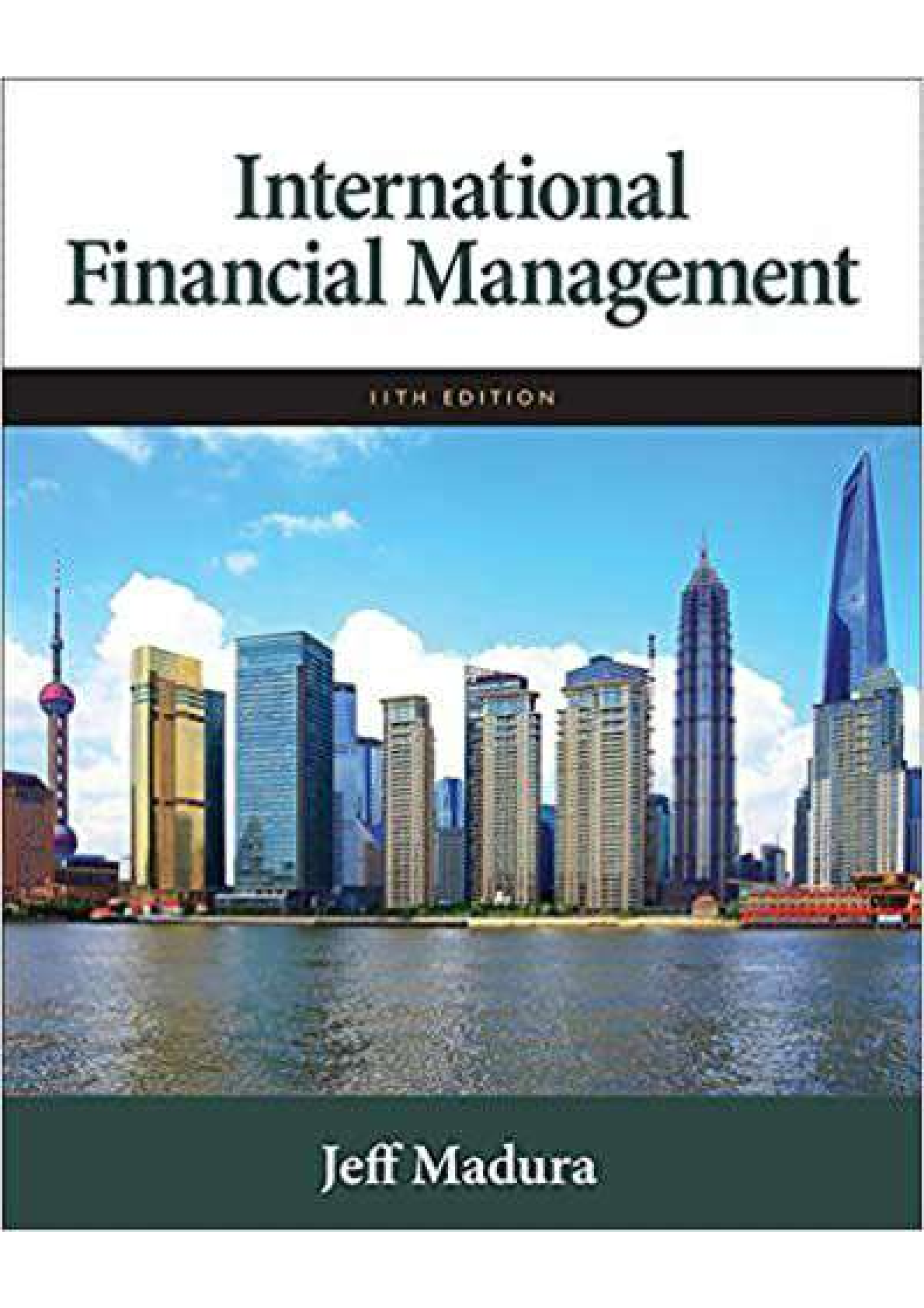
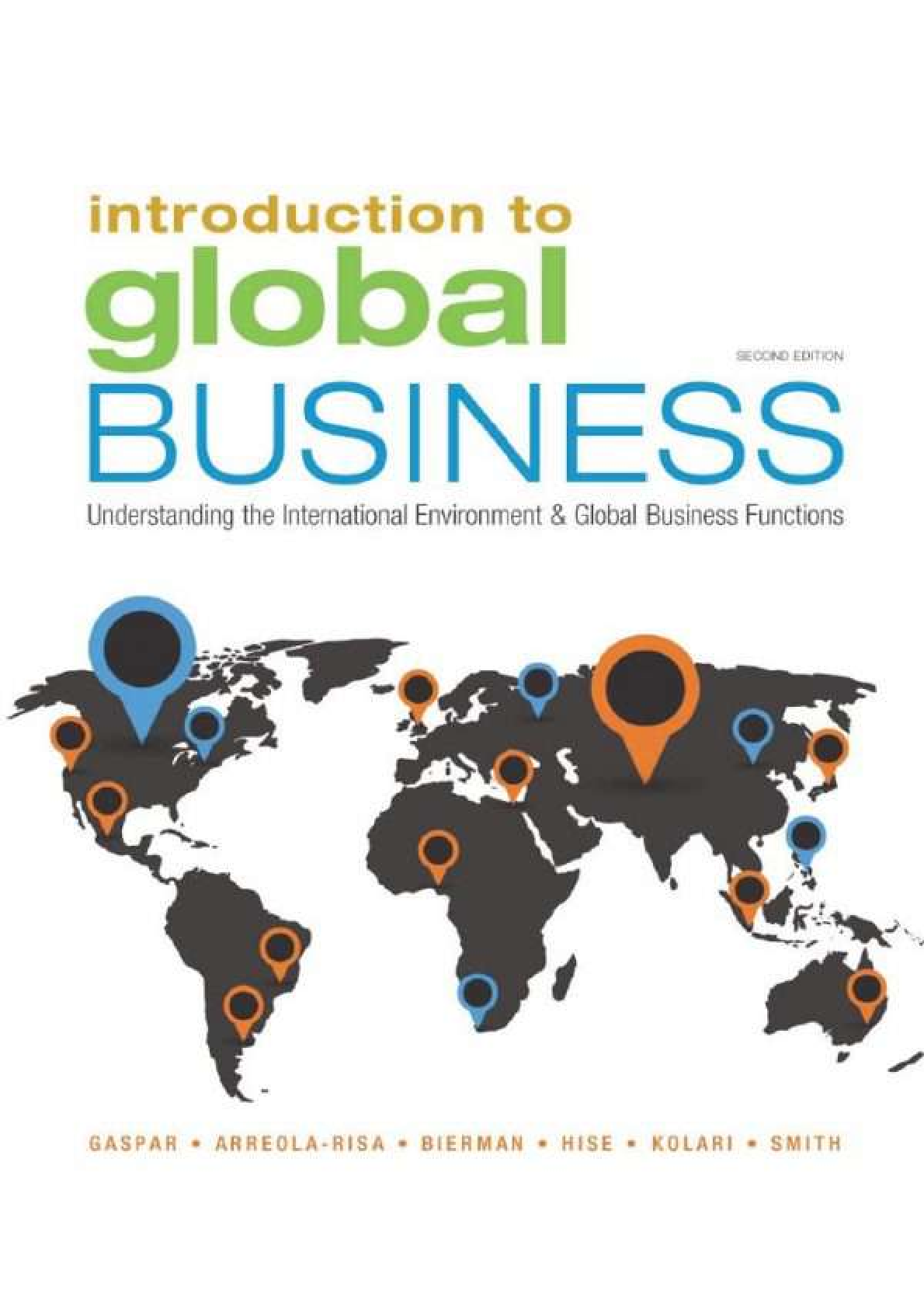
.png)

.png)
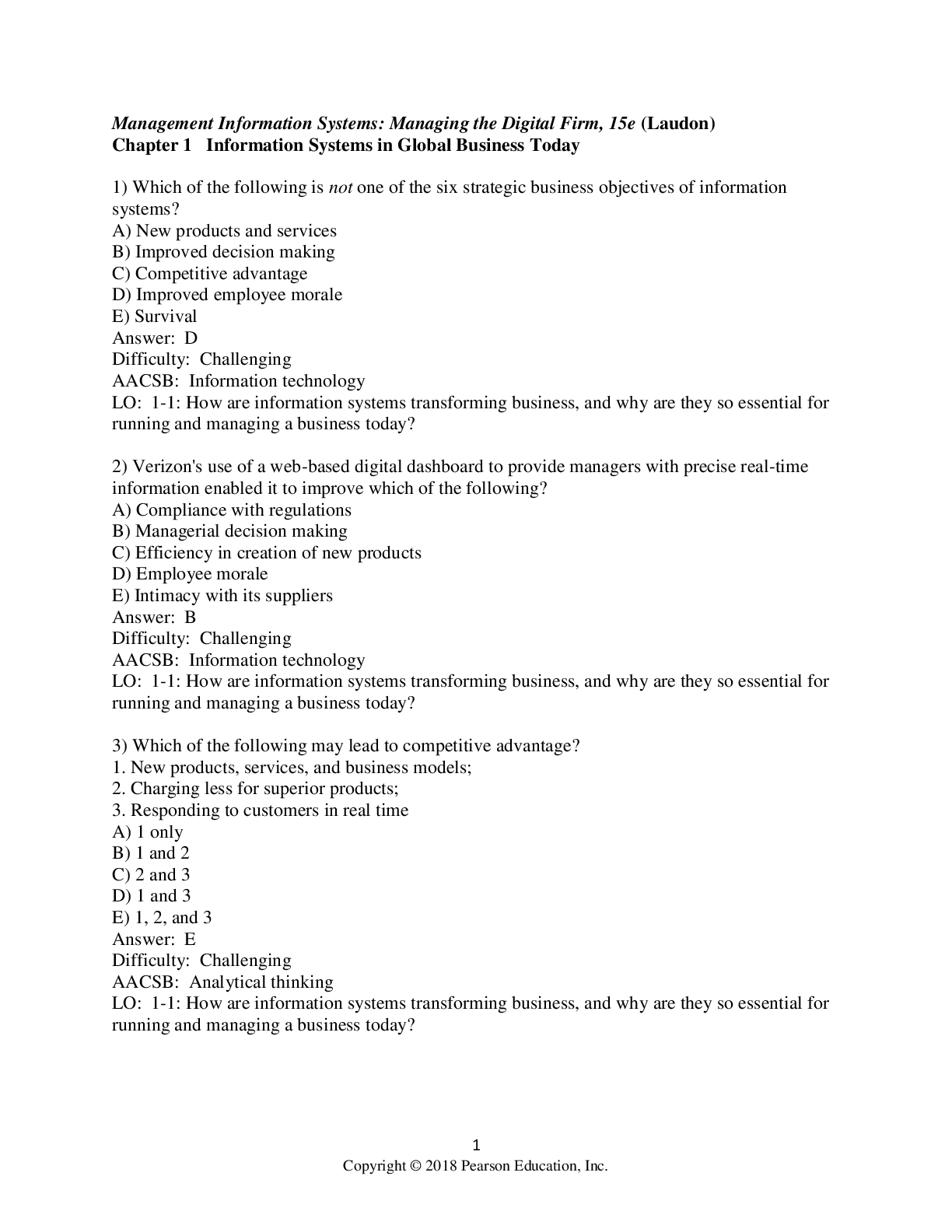
.png)
.png)
